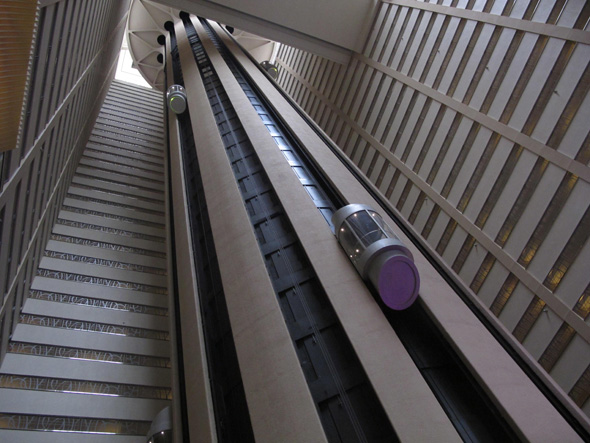
Modest-sized and monochromatic, the lower lobby of the Marriot Marquis in Times Square doesn’t seem like the sort of structure that would support a cavernous 45-story hotel sitting directly on top of it. However, once you step into one of the hotel’s famously futuristic elevators and zoom up the building’s center, you forget about the lobby altogether: it’s part of the past now.
In fact, the hotel’s lobby is part of the past — or, at least, the ground underneath it is. Up until 1982, this patch of land used to be the home of three theatres: the Morosco, the Bijou, and the Helen Hayes. Tuesday, the Landmarks Preservation Commission auctioned off pieces of the latter.
The Helen Hayes Theatre, located at 210 West 46th Street, was truly a sight to behold. Designed by theatre specialists Henry Herts and Hugh Tallant in 1911, the building — originally named the Folies Bergère — boasted a buttercream-colored façade replete with lavish colonnettes and alternating terra cotta panels. Renamed the Fulton Theatre later that year, the building eventually went on to become the site of Audrey Hepburn’s 1951 American debut in “Gigi.”
In 1955, the Fulton was renamed the Helen Hayes, after the famous actress known to many as the “First Lady of Theatre.” One of the few performers to have completed an EGOT — specifically, one Emmy, one Grammy, two Oscars and two Tonys — Hayes began acting at age five (as an “Irish Dancer” in the play Miss Hawke’s May Ball) and continued performing until she was 85 (her last performance, as Miss Marple in the TV movie Murder with Mirrors, aired in 1985.) Her most famous performance, as Queen Victoria in Laurence Housman’s “Victoria Regina,” helped the play gross $1.2 million at the box office, despite debuting during the Great Depression.
When representatives of Atlanta-based developer John Portman announced their plans to build the Marriot Marquis in 1973 — and raze the Helen Hayes Theatre in the process — theatre-lovers were not too pleased. In the spring of 1982, hundreds of members of the New York theatre community, including actor Christopher Reeve and producer Joseph Papp, held protests at the Helen Hayes and Morosco Theatres. Tensions reached a boiling point on March 22, when 165 people were arrested at the Helen Hayes site.
Jeffrey Schwager, a business owner who sells designer clothes wholesale in the Garment District, was one of those present at the 1982 protests. Although he was not arrested on March 22, he does recall a general feeling of disgust with the New York political establishment.
“There’s so much time that goes into these buildings — so much beauty and history,” he said. “Every time we take one of them down, New York loses some of its magic.”
Despite the Helen Hayes Theatre’s vibrant history, many people have forgotten about the old building. In fact, many recent guests of the Marquis didn’t even know it had existed.
Even those who did know about the original theatre still had no idea that parts of it were being auctioned off. One man, who refused to give his name, claimed to be unaware of the auction even though he currently works for the new, smaller Helen Hayes Theatre, located at 240 West 44th Street. Originally called the Little Theatre, the new Helen Hayes was christened in 1983 after the old Helen Hayes — since known as the First Helen Hayes — was torn down.
Marquis employee Raymond Abbott didn’t know about the auction either — but he had heard a myth connecting the First Helen Hayes Theatre with the Stephen Sondheim/James Goldman musical “Follies,” currently playing in the Marriot’s very own Marquis Theatre.
“Rumor has it that ‘Follies’ was actually inspired by the destruction of the Helen Hayes,” said Abbott. “They say that Sondheim found a picture of Gloria Swanson in the middle of the rubble, and then came up with the idea for the musical.”
“Follies” may be about a crumbling Broadway theatre on the verge of demolition, but it was written between 1965 and 1971 — about ten years before the Helen Hayes Theatre was taken down in 1982. In fact, Sondheim reportedly came up with the idea for the musical in 1965 when co-writer James Goldman saw a newspaper piece about a reunion of Ziegfeld girls.
Parts of the First Helen Hayes Theatre have already been used to build the Shakespeare Center — home of the Riverside Shakespeare Company — as well as the lobby of a supported housing development at Eighth Avenue and 43rd Street. And of course, people can still attend the new Helen Hayes Theatre, currently the home of “Rock of Ages.”
The final show to run at the First Helen Hayes was “I Won’t Dance,” a David Merrick production which only ran for one night in 1981 — the tired final breath of a theatre in its dying days. However, with the recent auction sale, the theatre — or at least its remnants —may have a chance to live again.